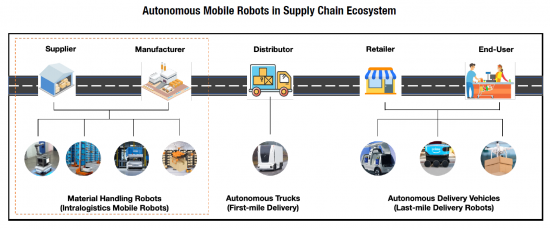 |
市场调查报告书
商品编码
1604917
仓库自动驾驶搬送机器人(AMR)的全球市场 - 2024年版Warehouse Autonomous Mobile Robot (AMR) Market - Edition 2024 |
||||||
价格
简介目录
样品view

- 在新冠肺炎 (COVID-19) 疫情期间和之后,自动化在仓储行业中占据主导地位。
- 仓库中的 AMR 市场是一个快速成长的产业,其推动因素是仓库营运自动化需求的不断增长以及对经济高效的解决方案的需求。
- 自 2023 年起,技术投资大幅成长,主要得益于关键市场被压抑的需求和经济復苏。
- 美洲和欧洲市场预计将占据重要的市场占有率,并且预计在 2023 年至 2030 年的预测期内销量将逐渐增加。
信息图形

- 亚洲正迅速采用自主运输机器人 (AMR),特别是在中国、日本和韩国等国家。
- 由于製造业和物流业的蓬勃发展以及机器人自动化的广泛采用,东协预计将成为关键的成长市场,这相当于 GDP 成长约 5%。
- 仓库 AMR 市场高度分散,市场上有多个利益相关者,包括 OEM、技术公司、软体和人工智慧公司、地图和在地化提供者、系统整合商和服务提供者。
- 人工智慧有潜力影响自主运输机器人 (AMR) 的性能和功能,扩展其适应和学习能力。仓库防火墙后面的专用 5G 网路提供安全性、资料控制和卓越效能,实现快速、低延迟、即时移动和避障。
- 仓储领域 AMR 市场的主要驱动力包括仓储营运中扩大采用自动化、对经济高效的解决方案的需求以及对电子商务和线上零售的需求不断增长。
- 工业 4.0 的日益普及、智慧工厂的趋势以及互联物流的兴起也正在推动市场成长。
- AMR 解决方案的高成本和市场缺乏标准化是 AMR 在仓库中发展的一些主要课题。
- 机器人即服务 (RaaS) 为机器人客户提供即用即付选项和全方位服务体验,使采用更易于管理。这种商业模式预计将大幅成长,到 2030 年将达到 35% 的市场收入占有率。
本报告调查分析了全球仓库自主移动机器人(AMR)市场,考察了仓库行业自主移动机器人(AMR)的市场渗透潜力、感测技术的创新以及各地区主要整车厂的情况并提供创业竞赛等资讯。
目录
第1章 调查范围与前提条件
第2章 调查手法 - 资料的分析与预测
第3章 仓库产业的自动化的现状
- 到 2030 年,超过 51% 的仓库将实现某种形式的自动化
- 从 2023 年到 2030 年,自动化仓库数量将以 17.5% 的复合年增长率增长
第4章 仓库自动化市场
第5章 仓库自动化的明细:各解决方案
第6章 仓库和物流的机器人的种类
第7章 仓库产业上自动化
- 在配送中心使用 AMR 预计可将营运成本降低 40%
第8章 自动驾驶搬送机器人(AMR)市场分析,出货台数和金额
第9章 自动驾驶搬送机器人(AMR)的零组件占有率:硬体设备·软体
第10章 自动驾驶搬送机器人(AMR)的收益占有率:不同商业模式 - RaaS模式和直销模式
第11章 仓库的自动驾驶搬送机器人(AMR)的种类 - 市场销售额(出货台数和金额)
- 库存运输机器人:市场销售额(出货台数和金额)
- GTP机器人:市场销售额(出货台数和金额)
- 分类机器人:市场销售额(出货台数和金额)
- 库存管理无人机:市场销售额(出货台数和金额)
第12章 与AMR的自规则感测技术选择
- AMR感测系统:市场分析与预测
- 光达市场规模及预测
- 相机市场规模及预测
- 雷达市场规模及预测
- AMR 中人工智慧和专用 5G 网路的数量
第13章 自动驾驶搬送机器人(AMR)市场:各地区
- 地区的明细:市场规模与预测
- 仓库产业上AMR的国家的分析
第14章 产业动态
- AMR 有助于加强和优化仓库供应链
- 营运支出的全新 RaaS b 模型
- 2024年仓库AMR投资分析
- 投资分析:按组成部分和地区划分
- 投资分析:依主要公司分类
- 自主运输机器人领域的重大收购(2022 年至 2024 年 8 月)
第15章 AMR的价格设定的分析
- 主要零组件和那个相关成本的整体明细
第16章 竞争的评估
- AMR市场企业的简介
- Geek+
- Locus Robotics
- Vecna Robotics
- GreyOrange
- ForwardX Robotics
- Symbotic (Acquired by Walmart)
- Seegrid Corporation
- Ocado
- AutoStore
- Fetch Robotics (Acquired by Zebra Technologies)
- 6 River Systems (Acquired by Shopify)
- MiR (Acquired by Teradyne)
- AutoGuide (Acquired by Teradyne)
- Gideon Brothers
- Syrius Robotics
- Guozi Robotics
- Bright Machines
- Youibot
- inVia Robotics
- Flexxbotics
- Balyo
- BlueBotics (Acquired by ZF Group)
- BrainCorp
- ATi Motors
- GrayMatter Robotics
- SVT Robotics
- InOrbit
简介目录
Executive Summary
With the ACES mobility research and analysis platform, M14 Intelligence is bringing the most in-depth analysis of autonomous, connected, electric, and shared mobility industry.
SAMPLE VIEW

This report plays a part in assisting stakeholders in understanding the possible Autonomous Mobile Robot's (AMR) market penetration in warehousing industry, technology innovations in sensing technologies and competition among the leading OEMs and start-ups across the geographies.
- Automation has recorded higher penetration in the warehousing industry during and after the covid-19 breakout.
- The AMR market in warehousing is a rapidly growing industry, driven by the increasing demand for automation in warehouse operations and the need for cost-effective and efficient solutions.
- Post 2023, the technology investments has rose sharply, majorly driven by the pent-up demand and economic recovery for the key markets.
- American and European markets are expected to hold significant market share and will witness gradual volume growth during the forecasted years of 2023-2030
INFOGRAPHICS

- The adoption of autonomous mobile robots (AMRs) in Asia is accelerating rapidly, particularly in countries like China, Japan, and South Korea
- ASEAN is expected to be a key growth market, owing to the boom in the manufacturing and logistics industries and the thrive to adopt of robotics automation to match the GDP growth of around 5%
- The AMR market in warehousing is highly fragmented, with several stakeholders operating in the market including OEMs, technology players, software and AI companies, mapping and localization providers, system integrators, and service providers
- AI impacts both the performance and functionality of autonomous mobile robots (AMR), potentially extending their capabilities in terms of adaptation and learning. While Private 5G network behind a warehouse firewall offers security, data control, and better performance and enables real-time mobility and obstacle avoidance with high speed and low-latency
- The major factors driving the AMR market in warehousing include the increasing adoption of automation in warehouse operations, the need for cost-effective and efficient solutions, and the growing demand for e-commerce and online retail
- The increasing adoption of Industry 4.0, the trend towards the smart factory and the growing trend of connected logistics are also propelling the growth of the market
- The high cost of AMR solutions and the lack of standardization in the market are some of the major challenges for growth of AMRs in warehousing
- Robot-as-a-Service (RaaS) allows robotics customers a pay-as-you-go option and gives them a full-service experience, making adoption more manageable. This business model is expected to grow dramatically reaching the market revenue share of 35% in 2030.
Report in numbers:
- 60+ pages of analysis on AMR market penetration and forecast
- More than 50 leading and emerging players analyzed
- More than 20 software and technology companies analyzed
- 20+ data tables and infographics on AMR analysis
- Interviews with 30+ stakeholders
- Analysis of top markets including US, China, Japan, Germany, France, and ASEAN countries
Countries covered:
Global (ASEAN countries, US, Canada, Germany, France, U.K., Japan, China, Others).
Companies mentioned:
|
|
TABLE OF CONTENTS
1. SCOPE OF RESEARCH AND ASSUMPTIONS
2. RESEARCH METHODOLOGY - DATA ANALYSIS AND FORECAST
3. Status of Automation in Warehousing Industry
- 3.1. Over 51 percent warehouses will have some form of automation installed by 2030
- 3.2. 17.5% CAGR growth in the number of automated warehouses from 2023 to 2030
4. Warehouse Automation Market
5. Warehouse Automation Breakdown by Solutions
6. Types of Robots in Warehousing and Logistics
7. Automation in Warehousing Industry
- 7.1. 40 percent reduction in operating cost is expected with the use of AMRs in DCs
8. Autonomous Mobile Robots (AMRs) Market Analysis Shipment and Value
9. Component Share in Autonomous Mobile Robots (AMRs): Hardware & Software
10. Revenue Share of Autonomous Mobile Robots (AMRs) by Business Model - RaaS Model and Direct Sales Model
11. Type of Autonomous Mobile Robots (AMRs) in Warehouses- Market Sale (Shipment & Value)
- 11.1. Inventory Transportation Robots: Market Sales (Shipment and Value)
- 11.2. Goods-to-Person Robots: Market Sales (Shipment and Value)
- 11.3. Sorting Robots: Market Sales (Shipment and Value)
- 11.4. Drones for Inventory Management: Market Sales (Shipment and Value)
12. Autonomous Sensing Technologies and Choices in AMRs
- 12.1. Sensing Systems in AMRs: Market Analysis and Forecast
- 12.2. LiDAR Market Size and Forecast
- 12.3. Camera Market Size and Forecast
- 12.4. Radar Market Size and Forecast
- 12.5. Artificial Intelligence and Private 5G Network Penetration in AMRs
13. Autonomous Mobile Robots (AMR) Market by Region
- 13.1. Regional Breakdown: Market Volume and Forecast
- 13.2. Country analysis of AMRs in Warehousing Industry
14. Industry Dynamics
- 14.1. AMRs are augmenting and optimizing the warehousing supply chain
- 14.1.1. Better cost efficiency and quick ROI
- 14.2. Emerging OpEx-oriented robots-as-a-service (RaaS) b-model
- 14.3. 2024 Investment Analysis of AMRs in Warehousing
- 14.4. Investment Analysis by Component and Region
- 14.5. Investment Analysis by Leading Players
- 14.6. Notable acquisitions in Autonomous Mobile Robots, 2022- Aug 2024
15. Pricing Analysis of AMRs
- 15.1. General breakdown of the key components and their associated costs
16. Competition Assessment
- 16.1. Profiles of companies in AMR Market
- 16.1.1. Geek+
- 16.1.2. Locus Robotics
- 16.1.3. Vecna Robotics
- 16.1.4. GreyOrange
- 16.1.5. ForwardX Robotics
- 16.1.6. Symbotic (Acquired by Walmart)
- 16.1.7. Seegrid Corporation
- 16.1.8. Ocado
- 16.1.9. AutoStore
- 16.1.10. Fetch Robotics (Acquired by Zebra Technologies)
- 16.1.11. 6 River Systems (Acquired by Shopify)
- 16.1.12. MiR (Acquired by Teradyne)
- 16.1.13. AutoGuide (Acquired by Teradyne)
- 16.1.14. Gideon Brothers
- 16.1.15. Syrius Robotics
- 16.1.16. Guozi Robotics
- 16.1.17. Bright Machines
- 16.1.18. Youibot
- 16.1.19. inVia Robotics
- 16.1.20. Flexxbotics
- 16.1.21. Balyo
- 16.1.22. BlueBotics (Acquired by ZF Group)
- 16.1.23. BrainCorp
- 16.1.24. ATi Motors
- 16.1.25. GrayMatter Robotics
- 16.1.26. SVT Robotics
- 16.1.27. InOrbit
02-2729-4219
+886-2-2729-4219









